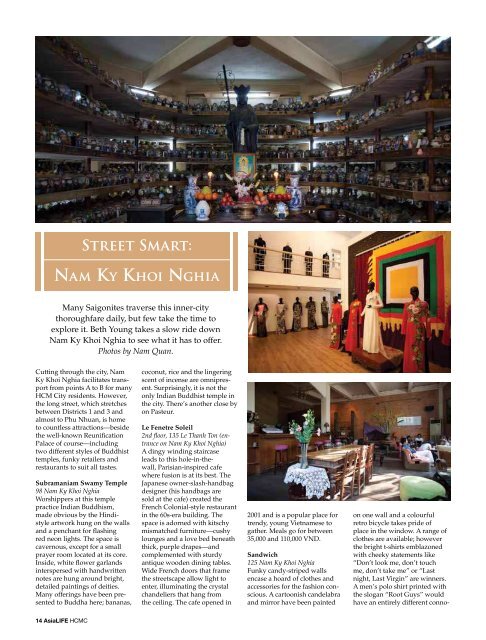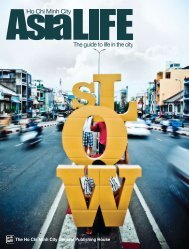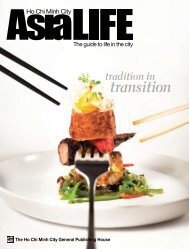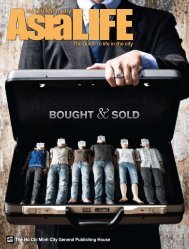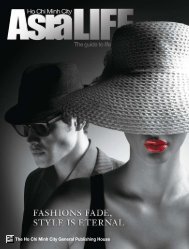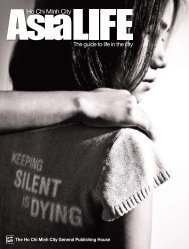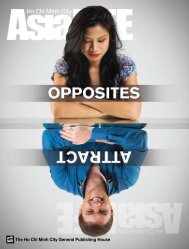Nam Ky Khoi Nghia - Asialife HCMC
Nam Ky Khoi Nghia - Asialife HCMC
Nam Ky Khoi Nghia - Asialife HCMC
You also want an ePaper? Increase the reach of your titles
YUMPU automatically turns print PDFs into web optimized ePapers that Google loves.
Street Smart:<br />
<strong>Nam</strong> <strong>Ky</strong> <strong>Khoi</strong> <strong>Nghia</strong><br />
Many Saigonites traverse this inner-city<br />
thoroughfare daily, but few take the time to<br />
explore it. Beth Young takes a slow ride down<br />
<strong>Nam</strong> <strong>Ky</strong> <strong>Khoi</strong> <strong>Nghia</strong> to see what it has to offer.<br />
Photos by <strong>Nam</strong> Quan.<br />
Cutting through the city, <strong>Nam</strong><br />
<strong>Ky</strong> <strong>Khoi</strong> <strong>Nghia</strong> facilitates transport<br />
from points A to B for many<br />
HCM City residents. However,<br />
the long street, which stretches<br />
between Districts 1 and 3 and<br />
almost to Phu Nhuan, is home<br />
to countless attractions—beside<br />
the well-known Reunification<br />
Palace of course—including<br />
two different styles of Buddhist<br />
temples, funky retailers and<br />
restaurants to suit all tastes.<br />
Subramaniam Swamy Temple<br />
98 <strong>Nam</strong> <strong>Ky</strong> <strong>Khoi</strong> <strong>Nghia</strong><br />
Worshippers at this temple<br />
practice Indian Buddhism,<br />
made obvious by the Hindistyle<br />
artwork hung on the walls<br />
and a penchant for flashing<br />
red neon lights. The space is<br />
cavernous, except for a small<br />
prayer room located at its core.<br />
Inside, white flower garlands<br />
interspersed with handwritten<br />
notes are hung around bright,<br />
detailed paintings of deities.<br />
Many offerings have been presented<br />
to Buddha here; bananas,<br />
coconut, rice and the lingering<br />
scent of incense are omnipresent.<br />
Surprisingly, it is not the<br />
only Indian Buddhist temple in<br />
the city. There’s another close by<br />
on Pasteur.<br />
Le Fenetre Soleil<br />
2nd floor, 135 Le Thanh Ton (entrance<br />
on <strong>Nam</strong> <strong>Ky</strong> <strong>Khoi</strong> <strong>Nghia</strong>)<br />
A dingy winding staircase<br />
leads to this hole-in-thewall,<br />
Parisian-inspired cafe<br />
where fusion is at its best. The<br />
Japanese owner-slash-handbag<br />
designer (his handbags are<br />
sold at the cafe) created the<br />
French Colonial-style restaurant<br />
in the 60s-era building. The<br />
space is adorned with kitschy<br />
mismatched furniture—cushy<br />
lounges and a love bed beneath<br />
thick, purple drapes—and<br />
complemented with sturdy<br />
antique wooden dining tables.<br />
Wide French doors that frame<br />
the streetscape allow light to<br />
enter, illuminating the crystal<br />
chandeliers that hang from<br />
the ceiling. The cafe opened in<br />
2001 and is a popular place for<br />
trendy, young Vietnamese to<br />
gather. Meals go for between<br />
35,000 and 110,000 VND.<br />
Sandwich<br />
125 <strong>Nam</strong> <strong>Ky</strong> <strong>Khoi</strong> <strong>Nghia</strong><br />
Funky candy-striped walls<br />
encase a hoard of clothes and<br />
accessories for the fashion conscious.<br />
A cartoonish candelabra<br />
and mirror have been painted<br />
on one wall and a colourful<br />
retro bicycle takes pride of<br />
place in the window. A range of<br />
clothes are available; however<br />
the bright t-shirts emblazoned<br />
with cheeky statements like<br />
“Don’t look me, don’t touch<br />
me, don’t take me” or “Last<br />
night, Last Virgin” are winners.<br />
A men’s polo shirt printed with<br />
the slogan “Root Guys” would<br />
have an entirely different conno-<br />
tation in Australia, though. It’s<br />
also a one-stop shop for lensless<br />
rhinestone framed novelty<br />
glasses, black vinyl jackets and<br />
denim slip-on shoes.<br />
BBQ Garden<br />
135A <strong>Nam</strong> <strong>Ky</strong> <strong>Khoi</strong> <strong>Nghia</strong><br />
If you’re new to HCM City and<br />
haven’t yet hit grill-it-yourself<br />
joint BBQ Garden for a birthday<br />
or farewell party, you surely<br />
will someday. The restaurant<br />
occupies a huge open space<br />
shaded by leafy trees that are<br />
lit with countless fairy lights<br />
come dark. At night, it is literally<br />
packed to bursting point<br />
with diners grilling up obligatory<br />
staples like succulent beef<br />
rolled with onion and cheese<br />
and tasty salmon and bacon<br />
skewers. Similar to 3T on Ton<br />
That Thiep, the BBQ Garden<br />
provides the same cuisine in a<br />
decidedly less frantic atmosphere.<br />
HCM City Museum<br />
65 Ly Tu Trong (entrance on <strong>Nam</strong><br />
<strong>Ky</strong> <strong>Khoi</strong> <strong>Nghia</strong>)<br />
This huge colonial-style building<br />
is set among a lush garden<br />
that is home to American<br />
War-era relics. Rusted antiaircraft<br />
artillery, an F5 fighter<br />
that bombed the Independence<br />
Palace (now Reunification<br />
Palace) and a massive tank sit<br />
alongside a collection of classic<br />
cars that were used in the war<br />
effort. A Renault on display<br />
transported wounded soldiers<br />
from Go Vap to Cu Chi in the<br />
1968 Tet General Offensive. It is<br />
also said that a secret underground<br />
tunnel runs between the<br />
museum and the Reunification<br />
Palace and various other key<br />
sites in HCM City. There’s no<br />
burrowing anymore though.<br />
This alternative exit is safely<br />
gated and under lock and key.<br />
HCM City Court<br />
60 <strong>Nam</strong> <strong>Ky</strong> <strong>Khoi</strong> <strong>Nghia</strong><br />
Perched atop this imposing<br />
mustard-coloured, French-built<br />
structure is a statue of the God<br />
of Justice. On either side of<br />
him sits a traditionally dressed<br />
Vietnamese couple, a woman in<br />
an ao dai and a man wearing a<br />
conical hat. From the building’s<br />
precipice, a pointed metal rod<br />
shoots skywards. It’s a lightning<br />
conductor that’s meant to<br />
signify the god’s ability to dole<br />
out justice through the court<br />
system.<br />
Y Ngoc Gallery<br />
135 <strong>Nam</strong> <strong>Ky</strong> <strong>Khoi</strong> <strong>Nghia</strong><br />
Famous Vietnamese ao dai<br />
designer Si Hoang displays his<br />
elaborate creations at his twostorey<br />
gallery, right next to the<br />
Reunification Palace. Hoang has<br />
been designing ao dai for more<br />
than 20 years, and it shows. The<br />
ornately designed traditional<br />
dresses are spun from highquality<br />
silks, cottons and regal<br />
velvets. Many are embellished<br />
with glittering beads and<br />
jewels, and others are painstakingly<br />
hand painted. At USD<br />
$700 a pop, Hoang’s creations<br />
are wearable artworks.<br />
Oriental Medical Clinic<br />
162 <strong>Nam</strong> <strong>Ky</strong> <strong>Khoi</strong> <strong>Nghia</strong><br />
This Korean-run clinic specialises<br />
in traditional Chinese<br />
14 asialife <strong>HCMC</strong> asialife <strong>HCMC</strong> 15


